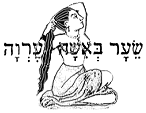|


It appears that women in ancient Israel generally grew their hair long and let
it fall down to their shoulders. Isaiah's description of the hairstyles of the
women of Jerusalem indicates that they also wore it gathered, or in plaits as
gathered and rolled into a knot at the back of the head, or in plaits (Mesopotamian
style).[1] At the same time, it was customary
in biblical times for women to cover their heads with veils or scarfs, as a
sign of chastity and modesty, The unveiling of a woman's hair was considered
a humiliation and punishment (as in the case of adultery).[2]
The custom compelling Jewish women to cover their hair on all is described
in the Mishnah as a "Jewish Ordinance"; if a woman walked bareheaded
in the street, her husband could divorce her without repaying her dowry.[3]
Later on, the custom was explained by a reference to Numbers 5:18, "And
the priest shall set the woman before the Lord and let the hair of the woman's
head go loose."[4] This injunction
was held to imply that in ordinary circumstances the Hebrew woman covered her
hair.
According
to the Mishanic injunction, girls did not have to cover their
hair until the wedding ceremony; indeed, if a Jewish girl went
with uncovered head, it was presumptive evidence that she was
unmarried.[5]
It later become common in many Sephardi communities for unmarried
girls to cover their hair as well, possibly under influence of
Moslem custom.
 What
may at first have been a modest etiquette grew into a scrupulous
rule. Some aggadic sources began to interpret this custom as a
sign of woman's shame and feeling of guilt for Eve's sin,[6]
while the rabbis compared exposure of a married woman's hair to
the exposure of her privy parts (and forbid the recital of any
blessing in the presence of a bareheaded woman).[7] What
may at first have been a modest etiquette grew into a scrupulous
rule. Some aggadic sources began to interpret this custom as a
sign of woman's shame and feeling of guilt for Eve's sin,[6]
while the rabbis compared exposure of a married woman's hair to
the exposure of her privy parts (and forbid the recital of any
blessing in the presence of a bareheaded woman).[7]
>While more
pious women took care not to uncover their hair even in the house,
the general custom in the late Middle Ages was to appear in public,
and in the presence of strange men, with covered hair.[8]
Toward the end of the 18th century some circles of East European women began
to wear a wig (shaytl). Many religious authorities protested against
this "innovation," viewing it as a sign of assimilation, and pointing
to the nuns as worthy of imitation by the daughters of Israel.[9]
The women persisted nonetheless, and the wig has become common attire in many
orthodox circles.
In modern
times, only the strictly Orthodox insist on women covering their
hair all the time. It remains the practice in most Orthodox, and
in many non-Orthodox congregations, for women to cover their hair
in synagogue.
|
[1] Isaiah 3:24 [back]
[2] Isa, 3: 17: Num, 5:18; III Macc, 4:6;
and Sus, 32 [back]
[3] Mishnah Ketubbot 7:6; B.
Kamma 8:6 [back]
[4] BT Ketubbot 72a; Sifre 1:2 [back]
[5] Mishnah Ketubbot 2:1,10;
BT Berakhot 24a [back]
[6] Gen, R, 17:8; Er, 100b and Rashi; Paul
in I Cor, II: I 16 [back]
[7] Ber 24a [back]
[8] Shulkhan Aruch (Code of Jewish
Law) EH 21: 2 [back]
[9] Moses Sofer, Samuel Katznellenogen [back] |
HAIR
Table of Contents
|